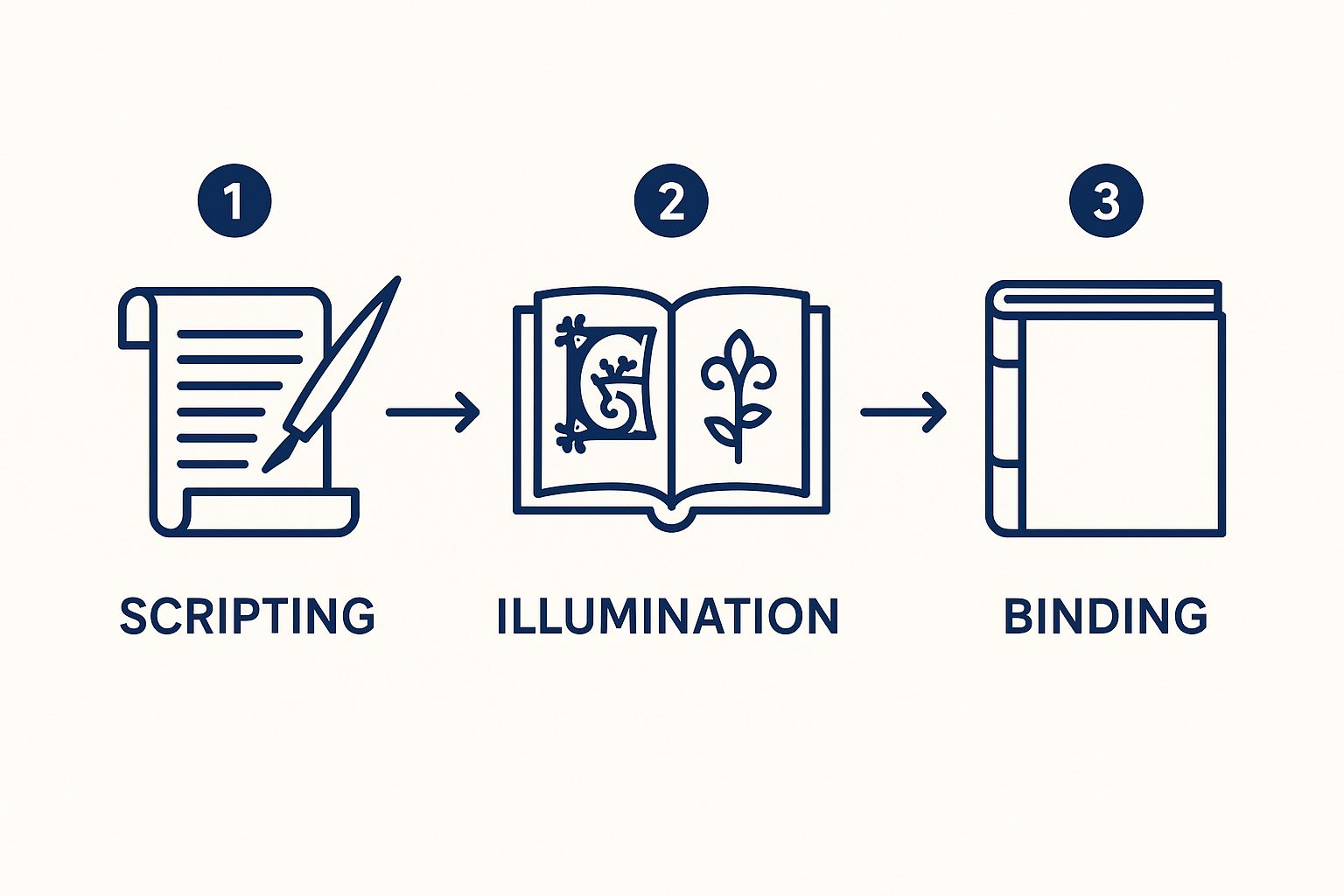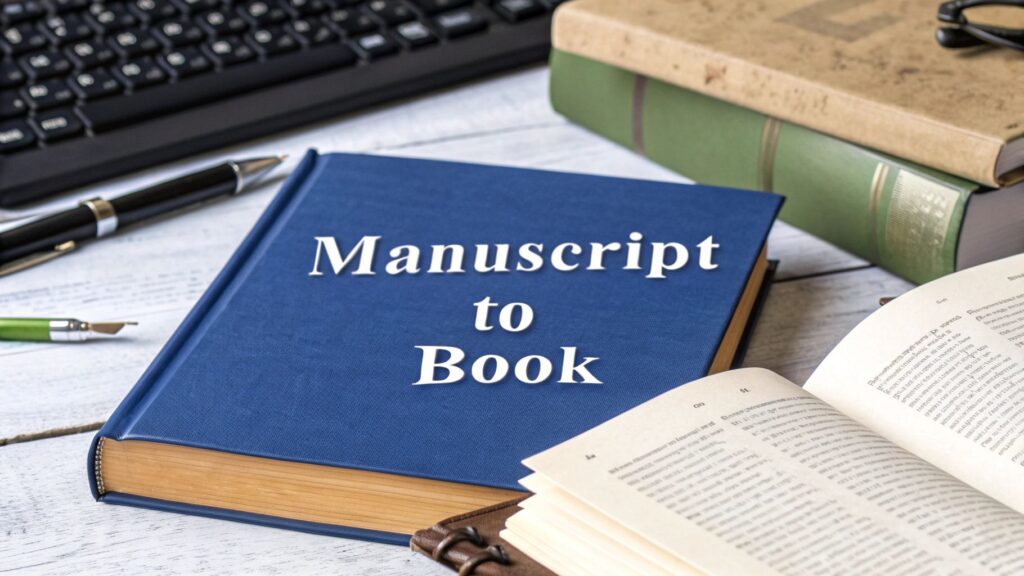Before a book ever lands on a shelf, it starts its life as something much more raw and personal: a manuscript. Think of it as the complete, unpolished draft of an author’s work. It's the story in its purest form, the architect's blueprint before a single brick of the final house is laid. It contains the entire vision, but it hasn't yet gone through the professional editing, design, and printing that turns it into the book you hold in your hands.
So, What Is a Manuscript Book, Really?

The word "manuscript" might bring to mind ancient scrolls or monks painstakingly writing by candlelight. And that's not far from its historical roots! The term comes from the Latin words manu (by hand) and scriptus (written), a nod to a time when every single book was created manually. You can get a deeper sense of how this definition has evolved from its origins.
These days, of course, a manuscript is almost always a digital file. When an author types "The End" on their novel, that finished Microsoft Word or Google Docs file is the manuscript. It’s the raw material—all the plot twists, character development, and dialogue, just as the author first imagined it.
A manuscript is the foundational stage of any published work. It represents the purest form of the author’s vision before it is shaped and polished by editors, designers, and publishers.
This distinction is absolutely critical for any writer to understand. A manuscript is a private document, the version you share with potential agents or editors. A published book, on the other hand, is a finished, commercial product designed for the public.
To make this crystal clear, let's break down the key differences.
Manuscript vs Published Book at a Glance
This table offers a quick comparison of the key characteristics that differentiate an author's manuscript from a final, published book.
| Attribute | Manuscript Book | Published Book |
|---|---|---|
| Stage | Pre-publication, author's draft | Post-production, final version |
| Formatting | Simple, functional (e.g., double-spaced, 12pt font) | Professional typesetting and design |
| Editing | Unedited or self-edited by the author | Professionally copyedited and proofread |
| Audience | Agents, editors, beta readers | The general public, readers |
| Cover | None; just a simple title page | Professionally designed cover art |
| Availability | Private document, not for sale | Commercially available in stores |
As you can see, the journey from one to the other involves a significant transformation, guided by a team of publishing professionals.
The Blueprint Analogy
I’ve found the best way to explain it is to think of a manuscript as a builder's blueprint. The blueprint:
- Contains the complete design—all the rooms, layouts, and structural details.
- Is absolutely essential for the construction crew (your editors and designers) to see the vision.
- Is not the finished house you actually live in.
In the same way, a manuscript provides the complete story but doesn’t yet have the professional touch that makes a book enjoyable and easy to read. It holds all the potential of a great book, but it's not the final product itself. For any aspiring author, grasping this difference is the first real step on the long but rewarding road to getting published. It’s the foundational document that can turn a passion project into a future bestseller.
The Evolution From Ancient Scrolls to Digital Files

Long before we had printing presses, let alone digital files, manuscripts were treated like rare treasures. For centuries, these meticulously handwritten documents were the only way to record and share stories, history, and knowledge. It was an incredible investment of time and skill.
Think about it: a scribe might spend months, or even years, copying an entire book by hand onto vellum (a specially prepared animal skin).
Many of these weren't just simple text. Famous examples like the Book of Kells showcase "illuminated" letters, intricately decorated with gold leaf and brilliant colors. This artistry transformed a book into a priceless artifact, underscoring just how valuable written information was before it could be mass-produced.
The Great Shift to Digital
Fast forward to today, and the painstaking labor of a scribe has been replaced by the familiar click of a keyboard. This leap from ancient scrolls to modern digital files is a story of incredible change. Authors now rely on word processors and can even use voice-to-text software to get their ideas down.
But here’s the thing: the core purpose of a manuscript hasn't changed at all. Whether it's written on parchment or typed into a Google Doc, it’s still the author's complete, raw vision, ready for the next steps to become a published book.
Technology has made writing more accessible than ever, but the fundamental creative process is remarkably similar. An author still pours their heart and soul into a single, comprehensive document. That document is the blueprint for everything that follows. The tools are different, but the spirit of the manuscript is alive and well.
How a Manuscript Differs from a Final Book

It’s a common mistake to think of a manuscript as a nearly finished book. In reality, that’s like looking at a pile of lumber and calling it a house. The core materials are there, sure, but one is a raw ingredient while the other is a polished, finished product ready for someone to move in.
A manuscript is a working document, pure and simple. It’s typically formatted for readability and ease of editing—think double-spaced text and wide margins—not for visual appeal. A published book, on the other hand, is a carefully designed commercial product. Every detail, from the font and chapter headings to the cover art, is chosen to create the best possible experience for the reader.
The journey from a simple text file to a bookstore-ready product involves multiple, distinct layers of transformation. It’s a collaborative effort that refines the author’s original vision into a polished, professional work.
This transition from a private draft to a public product is where the real magic of publishing happens.
From Raw Text to Polished Product
The most dramatic changes occur during the editing and design phases. An author's manuscript, no matter how clean they think it is, is just the first step. It has to pass through several critical stages before it ever reaches a reader's hands.
- Developmental Editing: This is the big-picture analysis. A developmental editor digs into the manuscript's structure, pacing, plot holes, and character development, suggesting major revisions to make the story itself stronger.
- Copyediting: Next, the focus zooms in to the sentence level. A copyeditor acts like a master mechanic, meticulously correcting grammar, punctuation, spelling, and syntax to ensure everything is clear, consistent, and professional.
- Proofreading: This is the final line of defense. A proofreader gives the text one last look-over to catch any lingering typos or formatting mistakes right before the book is printed.
These editing steps are intensive and absolutely essential for turning raw text into a coherent, error-free story. At the same time, the manuscript's plain pages are professionally typeset for the interior, and a graphic designer creates a compelling cover meant to grab a potential reader's attention.
The entire process is incredibly detailed, and learning how long it takes to publish a book really puts the amount of work involved into perspective. At the end of the day, a manuscript is the author's creation, but a book is the product of a whole team's expertise.
The Author's Journey from Manuscript to Bookshelf
So, what happens after an author triumphantly types "The End"? Finishing that first draft isn't the finish line; it’s more like the starting gun for the real race. A manuscript is a living, breathing thing at this stage, and it’s about to go through a major transformation before it ever sees a bookshelf.
This journey starts with the author, alone with their words. This is the self-editing phase, a time for the writer to be their own harshest critic. They’ll tighten up sentences, patch up plot holes, and generally polish that raw diamond until it starts to shine. It's all about getting the story into the best possible shape before letting anyone else lay eyes on it.
From there, the manuscript usually heads out to a trusted circle of beta readers. These are your first test audience, the brave souls who give you honest, early feedback from a reader’s point of view. Their fresh perspective is gold for catching confusing parts or character quirks that the author, deep in the weeds, might have missed entirely.
Securing Professional Representation
After revising the manuscript with that beta reader feedback, the author steps into the business world of publishing. The first move is typically writing a query letter—a sharp, one-page pitch meant to grab a literary agent's attention. Think of an agent as your advocate and business partner, the person who will champion your book in the industry.
The road to getting published is rarely a straight line; it demands a lot of grit. This image might show how medieval manuscripts were made, but the core idea of a careful, multi-step process is just as true today.

Just like ancient scribes moved from writing to illustrating to binding, a modern author's work moves through distinct phases of professional refinement.
From Acquisition to Publication
If your query letter works its magic, an agent will ask to see the full manuscript. If they fall in love with it, they'll offer to represent you. With an agent on board, your polished manuscript gets sent out to acquisitions editors at various publishing houses. This is the moment of truth, where your book is evaluated for its potential in the market.
A manuscript starts as a solitary creation, but a book is a team sport. The author’s private work is the foundation, but it’s the editors, designers, and marketers who help build it into a finished product for the public.
The statistics back this up. It's not uncommon for over 70% of manuscripts to go through several rounds of revision before a publisher even considers them. In fact, this prep work can eat up as much as 40% of a book’s total production timeline.
Once a publisher acquires your book, it enters a whole new level of professional editing—developmental editing for the big picture, copyediting for the fine details, and finally, proofreading to catch any last typos. Getting a handle on these stages is crucial, and diving into some essential editing tips can make a huge difference.
It all goes to show that learning how to become a published author is about so much more than just the writing itself. It’s about successfully navigating a challenging but incredibly rewarding journey of collaboration and persistence.
Understanding Different Types of Manuscripts
When you're ready to share your work, it’s crucial to know that not all manuscripts are treated the same. Think of it this way: you wouldn't send the same cover letter and resume for a job as a graphic designer and one as a financial analyst. The materials you prepare have to match the job—and in publishing, the genre.
Sending the right submission package shows an agent or editor you understand the industry. The biggest divide right off the bat is between fiction and non-fiction. For a novel, an agent will almost always expect to see the complete, polished manuscript. They need to be sure you can not only start a compelling story but also develop your characters and, most importantly, deliver a satisfying ending.
Proposals for Non-Fiction
Flip over to the non-fiction world, and the rules change completely. Here, you'll rarely send the full book. Instead, the industry standard is a detailed book proposal. This isn't just a summary; it’s the business plan for your book. It has to convince a publisher your idea is a smart investment.
A strong proposal typically includes:
- A clear overview of your book's core concept and who will buy it.
- A chapter-by-chapter outline that maps out the entire book.
- A market analysis showing how your book fits in (and stands out) among competing titles.
- A section on your author platform—why are you the right person to write this?
- One or two powerful sample chapters that prove you can deliver on your promise.
This approach is practical. It lets publishers gauge an idea's market potential before you spend a year or more writing the entire thing.
The type of manuscript you prepare signals your professionalism and understanding of the publishing industry. Sending the right package for your genre is the first step toward getting an agent or editor to take you seriously.
Other genres have their own unique requirements, too. Memoirs, for instance, are often treated like novels, requiring a full manuscript upfront. Academic books might need a proposal, much like general non-fiction. And children's books? They have their own world of strict word counts and submission rules.
Nailing these details is non-negotiable. A fantastic place to start getting these fundamentals right is by learning how to format a book for submission.
Your Manuscript Questions Answered
When you’re getting ready to query agents or submit to publishers, it's completely normal to have a million questions. You've poured your heart into this story, and you want to give it the best possible shot. Getting the small stuff right shows you’re a professional and makes a great first impression. Let's walk through some of the most common questions I hear from writers.
What Is the Standard Manuscript Format?
Think about it from an agent's or editor's perspective: they're sifting through hundreds of submissions. The last thing they want is to be distracted by funky fonts or weird spacing. The goal is to make your manuscript invisible so your story can shine.
Luckily, the industry standard is simple and has been for decades. Stick to this, and you can't go wrong:
- Font: 12-point Times New Roman. It's the gold standard for readability.
- Spacing: Double-spaced. Every single line. No exceptions.
- Margins: One-inch margins on all sides (top, bottom, left, and right).
- Alignment: Left-aligned only. Don't justify the text—that jagged right edge is what they expect to see.
- Indentation: Indent the first line of every new paragraph by half an inch. Use your word processor's ruler or paragraph settings, not the tab key.
How Long Should a Manuscript Be?
This is a big one, and the answer almost always comes down to your genre. In publishing, word count is the currency, not page count.
A good rule of thumb for a debut adult novel is somewhere between 80,000 and 100,000 words. If you're writing epic fantasy or sprawling sci-fi, you might get a little more leeway. For Young Adult (YA), the sweet spot is often a bit shorter, typically 60,000 to 80,000 words.
Do your homework here. Agents know the expected word counts for their genres by heart. Sending a 150,000-word contemporary romance or a 40,000-word thriller is often an instant "no" before they even read the first page.
Can I Submit Directly to Publishers?
The short answer is: probably not to the big ones. While it might seem like a good idea to go straight to the source, the vast majority of major publishing houses have a strict "no unsolicited manuscripts" policy. This means they won't even look at a submission that doesn't come from a literary agent.
Why? Agents are the industry's first line of defense. They curate submissions, find the gems, and present polished, promising manuscripts to editors. They're a trusted filter. A manuscript sent by an agent is solicited; one you send on your own is unsolicited. The first kind gets read, the second usually ends up in the "slush pile," which often means it's returned unread or deleted.
Your best bet is to focus on finding a literary agent. There are some exceptions, like small independent presses that accept direct submissions or specific open calls for anthologies, but for a traditional deal with a major publisher, an agent is your key to the door.
Ready to see your manuscript become a beautifully published book? BarkerBooks has guided over 7,500 authors on their journey to reaching readers across the globe. We handle everything—from meticulous editing and eye-catching design to worldwide distribution—so you can focus on what you do best: writing. Find out how we can bring your story to life.
